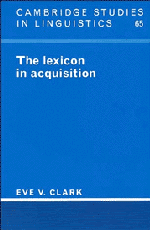Book contents
- Frontmatter
- Contents
- Acknowledgments
- 1 The lexicon: words old and new
- 1 LEXICAL ACQUISITION
- 2 Early lexical development
- 3 The mapping problem
- 4 Conventionality and contrast
- 5 Pragmatic principles and acquisition
- 6 Transparency and simplicity
- 7 Productivity
- 2 CASE STUDIES OF LEXICAL INNOVATION
- 3 CONCLUSION
- Bibliography
- Index of names
- Index of subjects
3 - The mapping problem
Published online by Cambridge University Press: 05 July 2011
- Frontmatter
- Contents
- Acknowledgments
- 1 The lexicon: words old and new
- 1 LEXICAL ACQUISITION
- 2 Early lexical development
- 3 The mapping problem
- 4 Conventionality and contrast
- 5 Pragmatic principles and acquisition
- 6 Transparency and simplicity
- 7 Productivity
- 2 CASE STUDIES OF LEXICAL INNOVATION
- 3 CONCLUSION
- Bibliography
- Index of names
- Index of subjects
Summary
Children acquiring words have a mapping problem. They must isolate the word-forms of their language; they must create potential meanings; and then they must map the meanings onto the forms. All three tasks are critical to the solution of the mapping problem in lexical acquisition. For present purposes, I presuppose that children can isolate the relevant forms. The focus in this chapter is on the creation of meanings and their mapping onto word forms. The early meanings children map onto forms are based on what they already know about the world around them (Clark 1983, Gibson and Spelke 1983, Mandler 1983). I therefore look first at the stuff early meanings are made from – children's ontological categories of objects, actions, properties, and relations. I then turn to mapping itself. Children appear to map meanings onto forms rather swiftly given the large numbers of words acquired in the early years. A number of people have proposed that the mapping task is made easier by children's reliance on various assumptions about the relations of words to the categories they denote. I look first at conceptual constraints on mapping, and then turn to lexical constraints.
Ontological categories
When children create possible meanings to map onto word forms, they do so by drawing on two kinds of information. They draw on their own experience, and they draw on patterns of use for each form in the input language they hear.
Information
- Type
- Chapter
- Information
- The Lexicon in Acquisition , pp. 43 - 66Publisher: Cambridge University PressPrint publication year: 1993
Accessibility standard: Unknown
- 1
- Cited by
